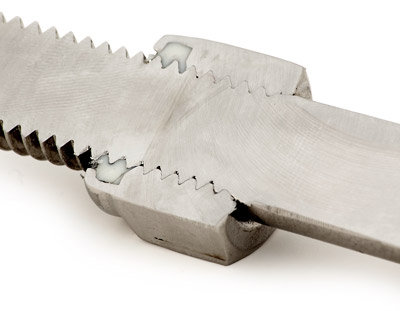Thread Galling
What is Thread Galling?
Thread galling occurs during installation when pressure and friction cause bolt threads to seize to the threads of a nut or tapped hole. It is also known as "cold welding".
Once a fastener has seized up from galling it is typically impossible to remove without cutting the bolt or splitting the nut.
What Bolts Are Susceptible To Galling?
Galling is most often seen in stainless steel (especially when using lock nuts), aluminum, and titanium. Fasteners with damaged threads and fine threads are particularly prone to galling. Hardened steel bolts, especially when zinc plated, rarely gall.
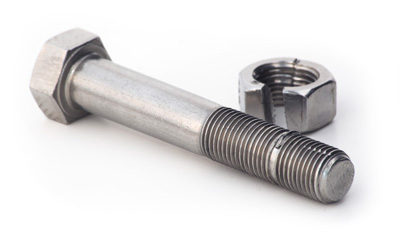
What Can I Do to Prevent Galling?
Slow Down Installation Speed
Because heat generated by friction is a contributing factor in galling, slowing down the installation speed can prevent galling. It is recommended that power tools not be used for the installation of stainless steel or other fasteners prone to galling. This is especially important when using nylon insert lock nuts as these nuts significantly increase the chance of galling.
Don't Use Bolts to Pull Joints Together
Bolts are not designed to pull together a joint or force materials into position. Doing so drastically increases the chance of galling. The materials being bolted should already be in place so the nut can be spun down by hand until the final tightening. If necessary, use clamps to hold the joint together during bolting.
Use a Lubricant
Special anti-seizing or anti-galling lubricants can be used to dramatically reduce the chance of galling. Examples include MRO Solutions Antiseize, Permatex® Anti-Seize Lubricant, Finish Line™ Anti-Seize Assembly Lube and USS Ultra Tef-Gel®.
Even a standard lubricant, such as WD-40®, can help reduce friction and prevent galling. Some nuts are available with a waxed finish to reduce the risk of galling.
Avoid Damaged or Dirty Threads
Check for damage to the threads of each bolt, especially bolts with fine thread. You should be able to put a standard nut on a bolt by hand. If not, it may indicate dented or damaged threads.
Also note that debris in the threads of a fastener can greatly increase the chances of galling. Always use clean parts.
Use Extra Care With Lock Nuts
Nylon insert lock nuts and, especially, prevailing torque nuts generate a large amount of friction and heat during installation. If you are experiencing galling problems, slow down installation speed or consider a different locking mechanism.
If a Fastener Begins to Bind: STOP
If a fastener begins to bind before you are actually tightening it down, stop immediately. Wait a minute or two to allow any heat to dissipate and then back the fastener off. Inspect the threads for damage and try again with a new nut.
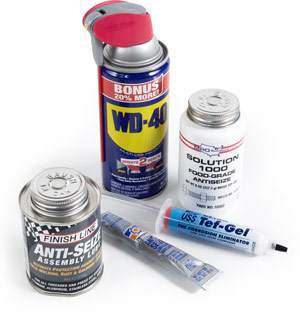
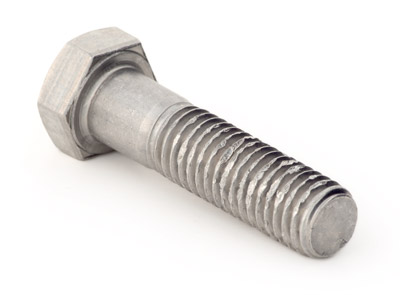
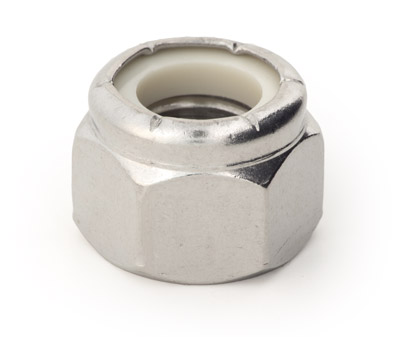
Why Fasteners Gall
Why Are Stainless Bolts Prone to Galling?
Stainless, aluminum, and titanium fasteners form thin protective oxide films on their exposed surfaces that prevent corrosion. In addition, this coating reduces friction and prevents direct metal to metal contact during fastening.
The protective oxide film can be rubbed or scraped off under the pressure and movement of the fastener being tightened. When this happens these relatively soft metals come into direct contact. Friction increases and the chance of galling increases significantly.
What Is Actually Happening?
Thread surfaces have microscopic high points that can rub together during fastening. In most cases this does not present a problem as the points slide over each other without damage.
Under certain conditions however, the surfaces will not slide past each other. The high points will then shear and lock together, greatly increasing friction and heat. As tightening continues the increased pressure results in more material being sheared off the threads. This cycle continues with even more shearing and locking until the threads are destroyed and the fastener will no longer turn in either direction.
